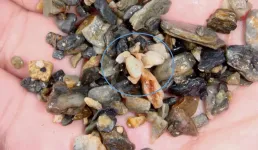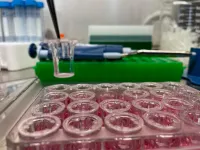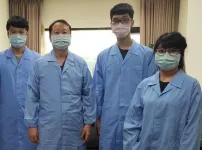(Press-News.org) Solar cells, which convert sunlight to electricity, have long been part of the global vision for renewable energy. Although individual cells are very small, when upscaled to modules, they can be used to charge batteries and power lights. If laid side-by-side, they could, one day, be the primary energy source for buildings. But the solar cells currently on the market utilize silicon, which makes them expensive to fabricate when compared to more traditional power sources.
That's where another, relatively new-to-science, material comes in - metal halide perovskite. When nestled at the center of a solar cell, this crystalline structure also converts light to electricity, but at a much lower cost than silicon. Furthermore, perovskite-based solar cells can be fabricated using both rigid and limber substrates so, alongside being cheaper, they could be more light-weight and flexible. But, to have real-world potential, these prototypes need to increase in size, efficiency, and lifespan.
Now, in a new study, published in Nano Energy, researchers within the Energy Materials and Surface Sciences Unit, led by Professor Yabing Qi, at the Okinawa Institute of Science and Technology Graduate University (OIST) have demonstrated that creating one of the raw materials necessary for perovskites in a different way could be key to the success of these cells.
"There's a necessary crystalline powder in perovskites called FAPbI3, which forms the perovskite's absorber layer," explained one of the lead authors, Dr. Guoqing Tong, Postdoctoral Scholar in the Unit. "Previously, this layer was fabricated by combining two materials - PbI2 and FAI. The reaction that takes place produces FAPbI3. But this method is far from perfect. There are often leftovers of one or both of the original materials, which can impede the efficiency of the solar cell."
To get around this, the researchers synthesized the crystalline powder using a more precise powder engineering method. They still used one of the raw materials-PbI2-- but also included extra steps, which involved, amongst other things, heating the mixture to 90 degrees Celsius and carefully dissolving and filtering out any leftovers. This ensured that the resulting powder was high quality and structurally perfect.
Another benefit of this method was that the perovskite's stability increased across different temperatures. When the perovskite's absorber layer was formed from the original reaction, it was stable at high temperatures. However, at room temperature, it turned from brown to yellow, which wasn't ideal for absorbing light. The synthesized version was brown even at room temperature.
In the past, researchers have created a perovskite-based solar cell with more than 25% efficiency, which is comparable to silicon-based solar cells. But, to move these new solar cells beyond the lab, an upscale in size and long-term stability is necessary.
"Lab-scale solar cells are tiny," said Prof. Qi. "The size of each cell is only about 0.1 cm2. Most researchers focus on these because they're easier to create. But, in terms of applications, we need solar modules, which are much larger. The lifespan of the solar cells is also something we need to be mindful of. Although 25% efficiency has previously been achieved, the lifespan was, at most, a few thousand hours. After this, the cell's efficiency started to decline."
Using the synthesized crystalline perovskite powder, Dr. Tong, alongside Research Unit Technician Dr. Dae-Yong Son and the other scientists in Prof. Qi's Unit, achieved a conversion efficiency of over 23% in their solar cell, but the lifespan was more than 2000 hours. When they scaled up to solar modules of 5x5cm2, they still achieved over 14% efficiency. As a proof-of-concept, they fabricated a device that used a perovskite solar module to charge a lithium ion battery.
These results represent a crucial step towards efficient and stable perovskite-based solar cells and modules that could, one day, be used outside of the lab. "Our next step is to make a solar module that is 15x15cm2 and has an efficiency of more than 15%," said Dr. Tong. "One day I hope we can power a building at OIST with our solar modules."
INFORMATION:
This work was supported by the OIST Technology Development and Innovation Center's Proof-of-Concept Program.
A team of researchers from the National University of Singapore (NUS) and the University of the Ryukyus has recently identified and described a bizarre new genus and species of xanthid crab found in Okinawa Island, Ryukyu Islands, Japan. Named Mabui calculus, it is unique among the 7,800 species of known crabs in having strongly asymmetrical male and female reproductive structures!
"Male crabs have a pair of reproductive parts called gonopods while females have a pair of vulvae. All crabs mate in the 'missionary position', so the gonopods pump sperm into females for internal fertilisation of the eggs. This was the accepted orthodoxy until our discovery - a small Japanese crab has evolved to do this very differently!" explained Professor Peter Ng, a world-leading expert in ...
Recent studies show that, in the future, the mercury concentration of fish in Finnish Lapland can shift closer to the level found in lakes located below the Arctic Circle. According to researchers, mercury content should be increasingly carefully investigated and monitored in fish and food webs, as the climate and land use change.
Mercury is a heavy metal found in nature. Methylmercury, a particularly toxic form of the metal, accumulates in fish and is biomagnified in food webs. Humans are exposed to methylmercury especially through fish-based diets.
Researchers investigated the joint effects of the climate and land ...
COLUMBUS, Ohio - Scientists are pursuing a new strategy in the protracted fight against the SARS-CoV-2 virus by engineering nanobodies that can neutralize virus variants in two different ways.
In lab studies, researchers identified two groups of molecules that were effective against virus variants. Using different mechanisms, nanobodies in each group bypassed mutations and disabled the virus's ability to bind to the receptor that lets it enter host cells.
Though vaccination is enabling the resumption of some pre-pandemic activities in parts of the world, ...
MISSOULA - The map of Montana Kayla Irish pulls up is peppered with red circles, each cluster providing details behind one of today's timely topics - childhood vaccination.
The project, led by Dr. Sophia Newcomer in the University of Montana's Center for Population Health Research, is the first spatial scan analysis to identify hotspots of undervaccinated children across Montana and evaluate whether they are due to social or geographic barriers.
CPHR is funded through the National Institutes of Health, and the analysis is part of a collaborative ...
Irvine, Calif., June 21, 2021 -- Cancer immunotherapy involving drugs that inhibit CTLA-4 also activates an unwanted response that may self-limit its efficacy in fighting tumors, according to a new study led by Francesco Marangoni, Ph.D., assistant professor of physiology & biophysics and member of the Institute for Immunology at the University of California, Irvine. Study results are published online in the journal Cell.
Using a person's own immune system - immunotherapy - to treat cancer may also stimulate T regulatory cells, which are essential for preventing autoimmunity, in which the body attacks healthy cells and tissue, but limit tumor control. Some anticancer drugs of the checkpoint inhibitor family block the molecule CTLA-4 and activate ...
Every year in Canada, six trillion litres of municipal wastewater are partially treated and released into the environment, while another 150 billion litres of untreated sewage are discharged straight into pristine surface waters.
Now researchers have found a way to stem that flow: by filtering the waste through the roots of willow trees. Experimenting with a plantation in Quebec, the scientists estimate that over 30 million litres of primary wastewater per hectare can be treated using 'bio-refinery' annually.
Their results were published June 14 in the journal ...
[Brooklyn, New York] - [June 21, 2021] - Applied Biological Laboratories (Applied Bio), a biopharmaceutical company focused on the respiratory disease market, announced that its study published online in Immunology, Inflammation and Disease was able to determine the mechanism behind respiratory inflammation and treat it effectively with Biovanta(TM), a 100% naturally derived, over-the-counter (OTC) drug for cold, cough and sore throat.
The study results also showed that almost all of the leading OTC products on the market can damage the upper respiratory cells and may prolong illness. This research study and its findings represent one of the first major breakthroughs in decades for the cold and flu market.
The study, titled ...
UNIVERSITY PARK, Pa. -- Clickbait headlines might not be as enticing to readers as once thought, according to a team of researchers. They added that artificial intelligence -- AI -- may also come up short when it comes to correctly determining whether a headline is clickbait.
In a series of studies, the researchers found that clickbait -- headlines that often rely on linguistic gimmicks to tempt readers to read further -- often did not perform any better and, in some cases, performed worse than traditional headlines.
Because fake news is a concern on social media, researchers have explored using AI to systematically identify and block clickbait. However, the studies also suggest ...
Amazon rain forests could be at far higher risk of extreme drought than previously thought, according to new research.
An international study, led by the University of Leeds, warns that huge areas in the eastern part of the Amazon face severe drying by the end of the century if action is not taken to curb carbon emissions.
As a result, large amounts of carbon dioxide would be released from the forest into the atmosphere,
adding to the greenhouse gas effect and driving further climate change.
The increased dryness during the Amazon dry season would further threaten the viability of large parts of the rainforest, as trees are already water stressed and there is greater risk of forest fires.
The predicted droughts could also have far-reaching consequences ...
Vanadium oxo (VO) species were often used to oxidise sulfide/amine compounds and alkenes when combined with peroxide oxidants. VO species are well known as important vitamin supplements for potential diabetic prevention. They are highly prevalent as metalloenzyme like haloperoxidase. The current catalyst class comprises VO species, substituted-salicylaldehyde, and alpha-amino acids that are nontoxic and highly enriched in ascidian sea animals and plants. Professor Chien-Tien Chen of NTHU pioneered aerobic asymmetric couplings of 2-naphthol with VO species to form optically active binaphols in 2001 (reported in C&EN News, 79(20), 45-57(2001)), which was believed to proceed in a VO-bound, single/dual-mode activation or free radical-radical/free ...





